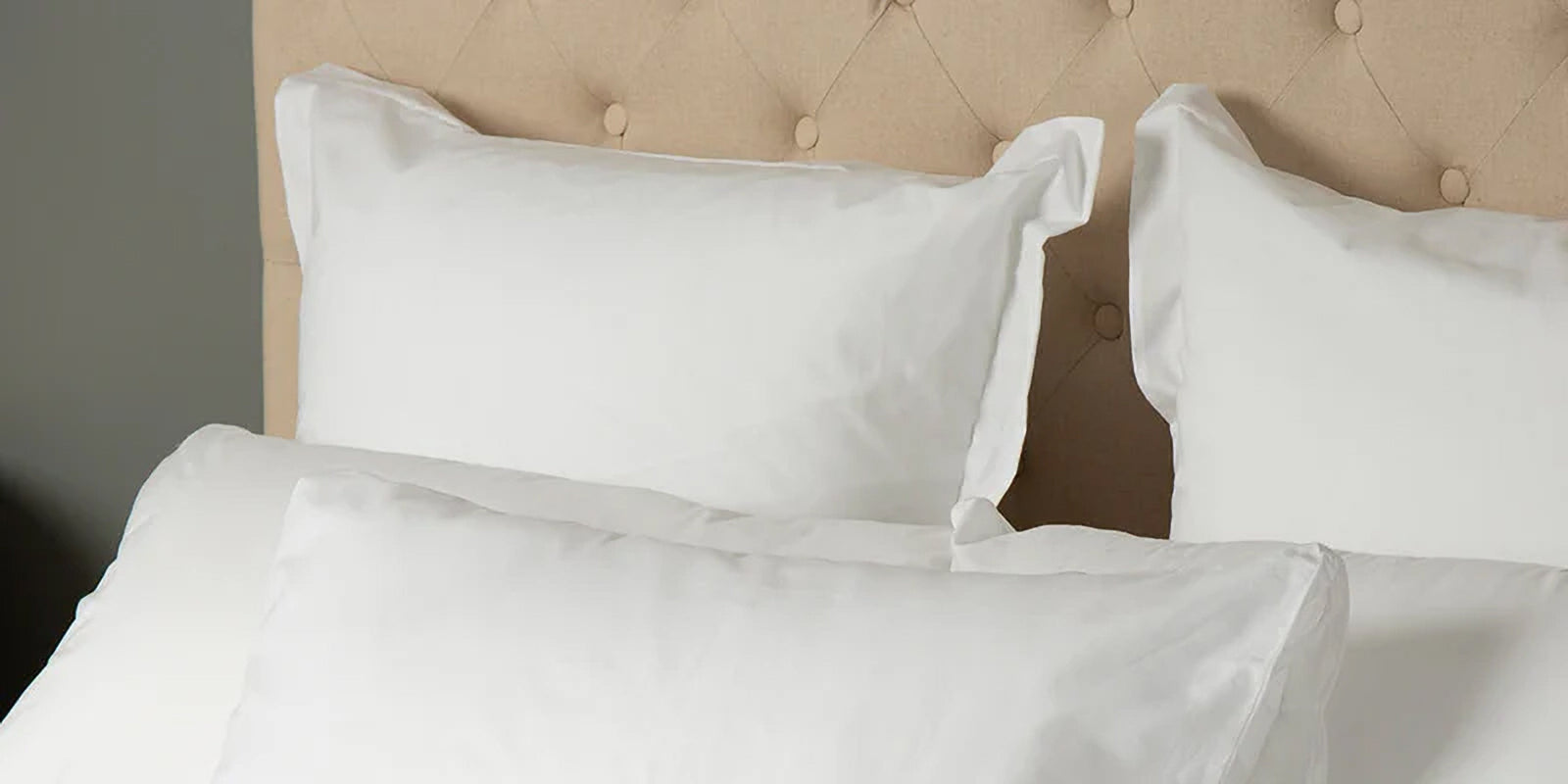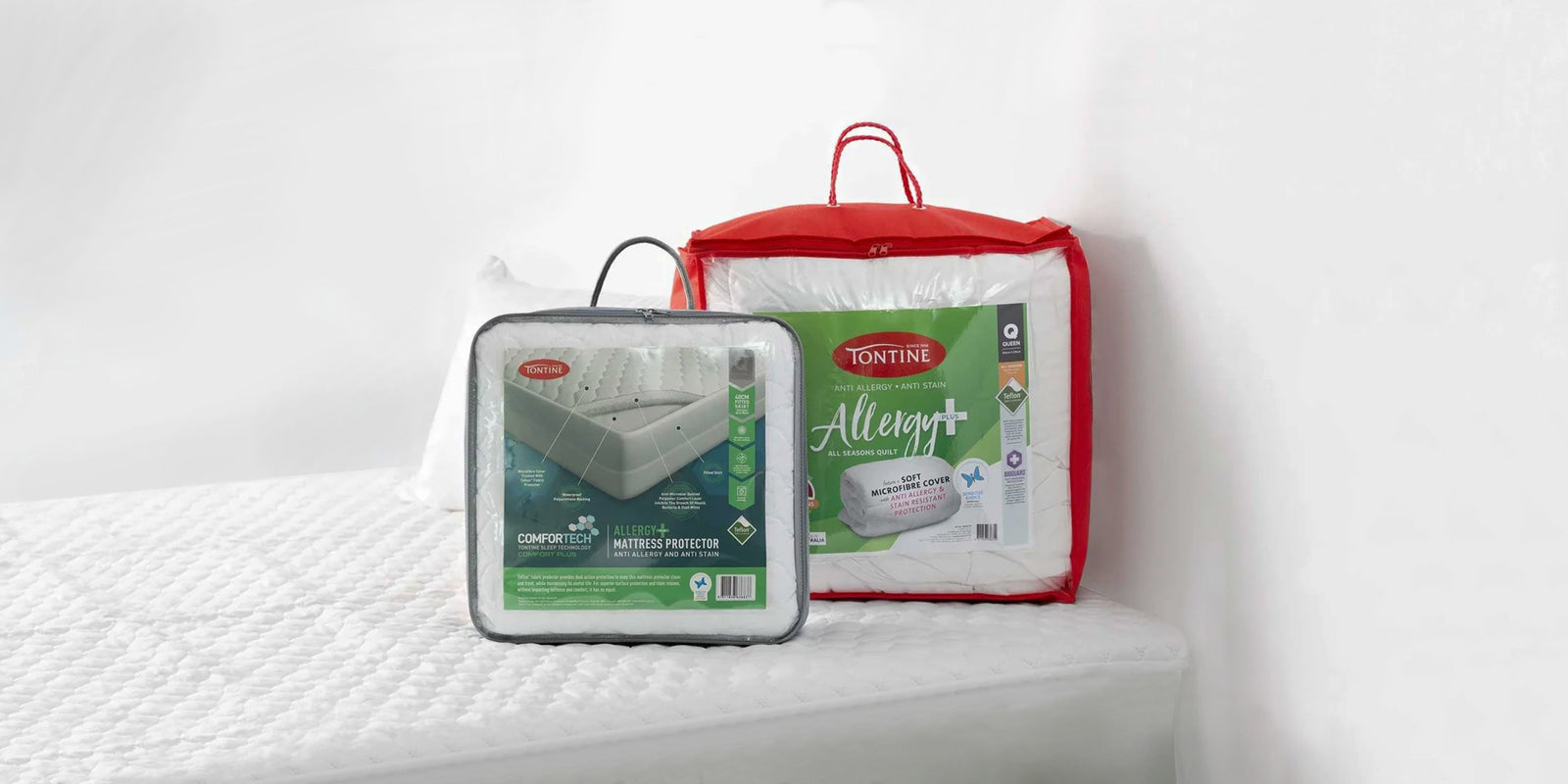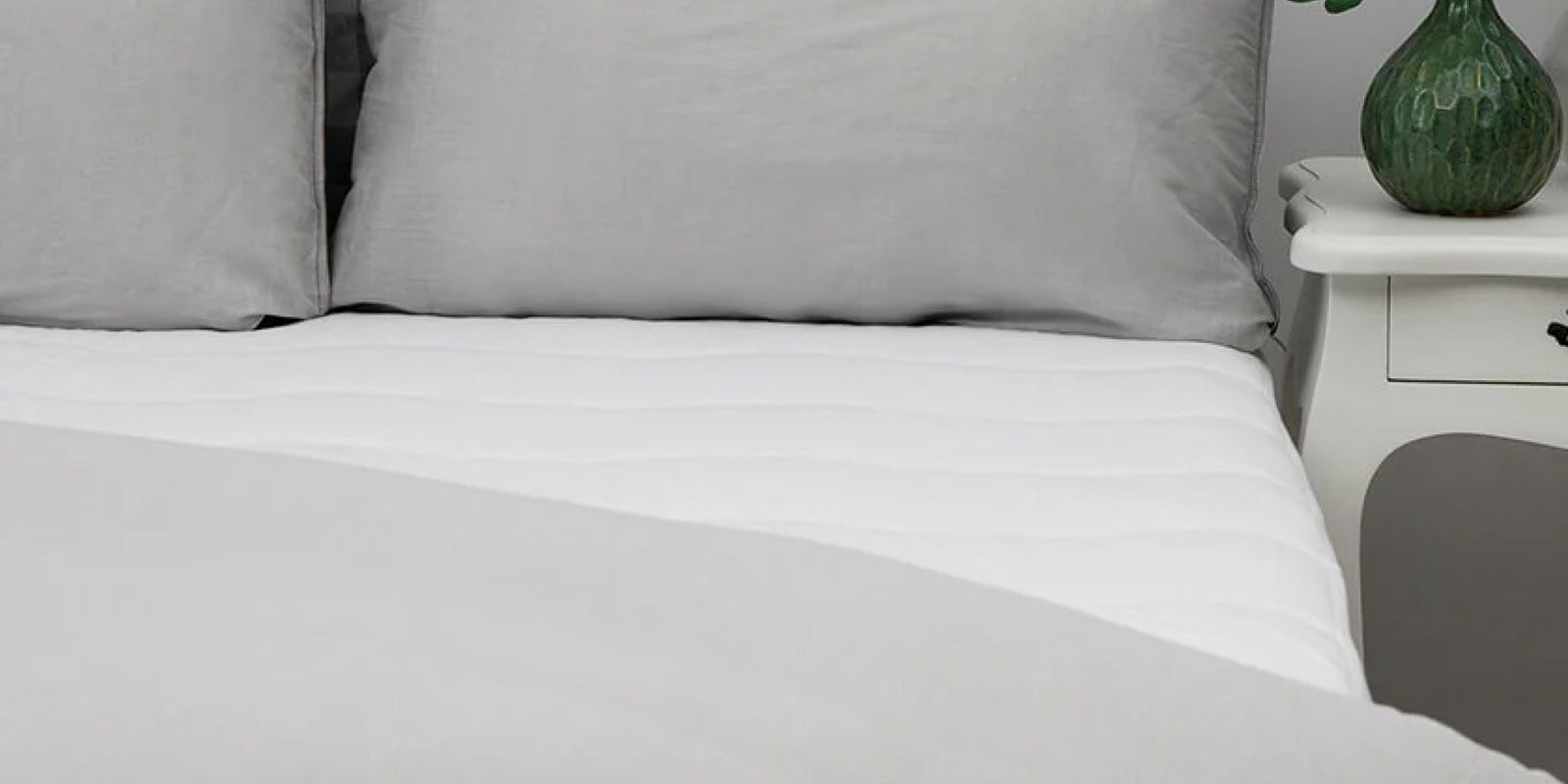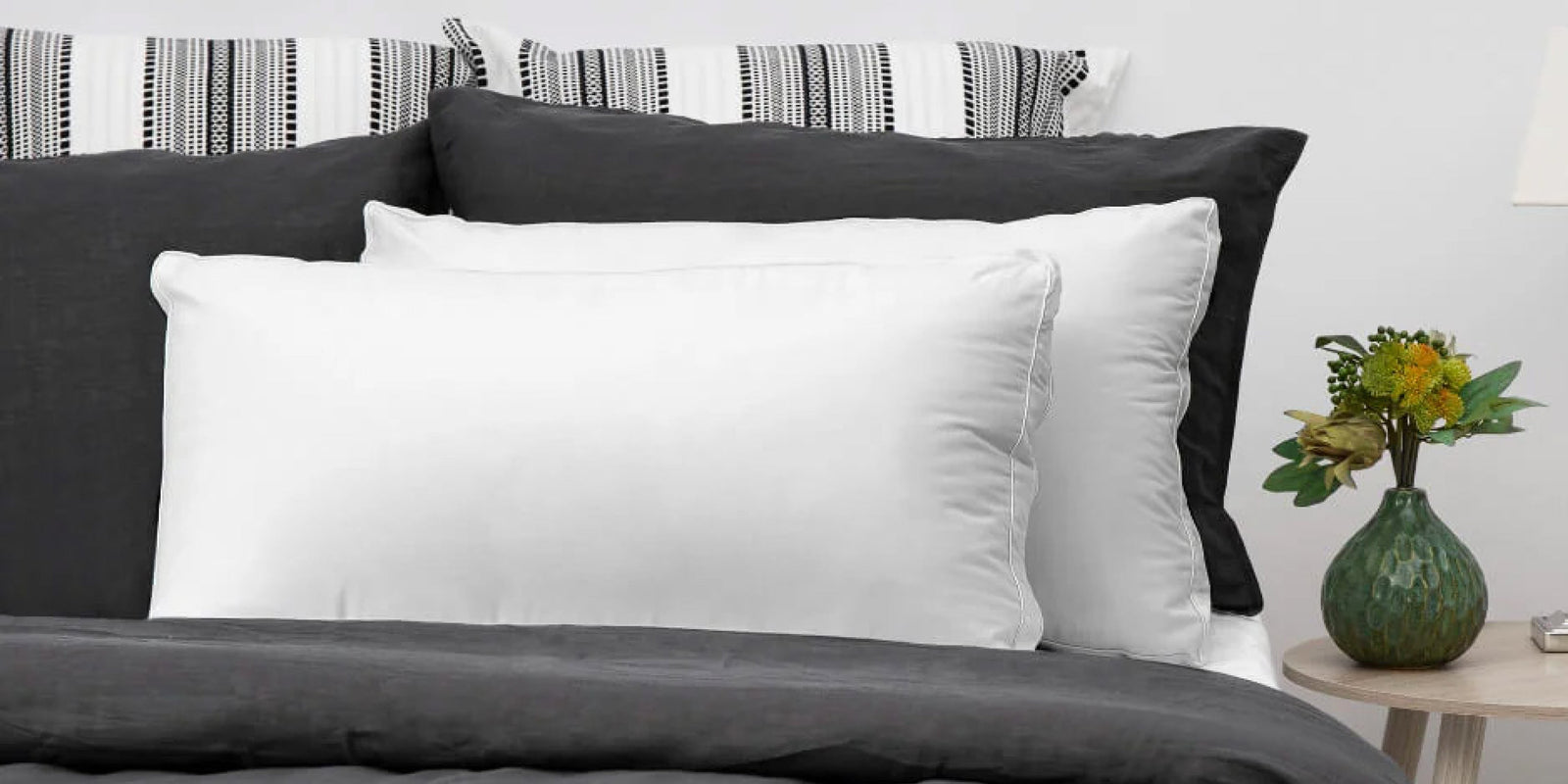Choosing the Perfect Pillow
Finding the right pillow for you or a loved one can be frustrating and confusing. This is made all the more difficult by the fact that you usually can’t return a pillow that doesn’t suit after testing it! This often causes people to wait too long before replacing pillows that are clearly already past their use by date.
Fortunately, at Tontine we have been providing Australian families with the widest possible range of comfortable, durable and affordable pillows for over 60 years. With the majority of our pillows made right here in Australia, you can trust they’re good quality.
With so many great pillows to choose from, you’re sure to find one that suits your needs.
Factors to Consider When Buying A Pillow
Most people try to make choosing a pillow as easy as possible, classifying themselves as a tummy, back or side sleeper and choosing a low, medium or high pillow to suit.
Unfortunately, it’s not quite that easy, and by oversimplifying the process there’s a good chance you’ll be wasting money at best or suffering from a sore back at worst. And although your sleeping position is by all means a valid consideration, it’s not the only one.
In this pillow buying guide, we’ll run you through all the factors you need to consider so you can find your perfect pillow:
- Your preferred level of comfort
- Your mattress
- Preferred sleeping position and your body size
- Spine health
- Pillow support
- Budget
- How often you want to replace it
- Special needs
- Filling material
Let’s take a look at each one in turn.
1. Pillow Comfort
Finding a comfortable pillow is an important consideration for your wellbeing. Although how comfortable a pillow is somewhat subjective, you can minimise the guesswork by doing some research and identifying your needs.
Generally speaking, how “comfortable” a pillow is refers to its softness. But be careful! The softest pillow might not actually be the best for you in reality.
In fact, the best pillow for you will strike a balance between comfort and support, and will be a good height for your body size and shoulder width - more on that later.
The filling of a pillow is important to consider when you’re looking at softness.
For example, the softest pillows are typically those filled with wool, feather and down, or very thin polyester fibre.
Materials generally regarded as firmer include memory foam and latex, but just as there are wool, feather and down and polyester pillows that offer support and firmness, so too are there soft memory foam and latex pillows.
To help you find the level of comfort you’re after, most pillows are classified into soft, medium or firm categories, including Tontine pillows.
2. Your Mattress
Along with your pillow, your mattress goes a long way in determining the quality of your sleep. And it’s the combination of your pillow and mattress that’s important, not just each in isolation, as that’s what keeps your spine neutral.
For example, if you have a soft mattress, a high profile pillow usually won’t be the best choice as it will create too much height once your body sinks into the mattress itself. On the other hand, if you have a firm mattress, you may need a high pillow to support your body.
 |
 |
 |
Generally speaking, the most important mattress considerations are whether your mattress is soft, medium or hard, and how old it is. The age of your mattress is also important, because older mattresses tend to sag with age. So although you may have a firm mattress, you may also need to consider that its age may contribute to it acting more like a medium or soft mattress.
3. Preferred Sleeping Position and Body Size
After you’ve taken into account your mattress, it’s time to add your preferred sleeping position and body size to the equation.
If you have a smaller frame and narrow shoulders, a low profile pillow will likely be best for you. If you are of average height with medium width shoulders, your best option will probably be a medium profile pillow. Likewise, if you have a larger frame and wider shoulders, a high profile pillow is likely to suit your needs.
However, this can all change depending on your preferred sleeping position - and it’s made all the more complicated by the fact that most people change their sleeping position through the night!
 |
 |
 |
If you’re wanting to prioritise sleep health, there are some general guidelines to follow depending on which position you spend the most time in each night.
If you’re in the majority that consider themselves to be a side sleeper, you should opt for a firmer pillow to prevent your head from sinking and putting unnecessary strain on your neck. You’ll most likely want a medium or high profile pillow, depending on your build. Or, a contour pillow might give you the support your neck needs.
 |
As sleeping on your stomach provides less spinal support compared to other sleeping positions, you’ll want to make sure you’re adequately supporting your body to avoid the repercussions of a twisted spine. We recommend a low profile pillow, or even no pillow at all that avoids placing extra strain on your neck. In addition, positioning a thin pillow underneath your hips will also help to even out your spine. |
 |
For back sleepers, medium pillows in both height and firmness tend to be the best option to promote neck and spinal alignment. However, if you are particularly lightweight, you might want to consider a low-profile or softer pillow to avoid so-called ‘text-neck’. |
To ensure you can find the perfect pillow, Tontine offers a range of pillows in different heights, with varying degrees of comfort and support that allow you to take into account both your body size and your preferred sleeping position. For example, you can choose a low profile pillow that is soft, medium or firm, or a medium profile pillow that is soft medium or firm.
There are also a few different options when it comes to the size of the pillow itself. Most of us are familiar with the standard pillow, which are the rectangular pillows that most pillowcases are designed to fit, as well as the square European pillows which are typically only decorative in Australia. Of course, it’s more than possible to actually sleep on European pillows - as they do in Germany - and you might find you enjoy the squarer shape and bigger size.
You’ll also occasionally come across queen size pillows on the Australian market. These are slightly bigger than your standard pillow, and are designed to minimise the gap between pillows when placed side by side on a queen size bed. Similarly, king pillows are popular choices for king and super king beds and might also suit you if you’re a bigger person.
Compare pillow dimensions below:
 |
47cm x 73xm |
 |
65cm x 65cm |
 |
51cm x 76cm |
 |
51cm x 92cm |
4. Spine Health
If you currently suffer from neck or back pain, the good news is that the right pillow can help you minimise or eliminate that pain. However, choosing poorly does risk making it worse!
People with existing pain in their neck and back typically need to consider support levels over any other pillow choice considerations. As latex and memory foam pillows generally provide the highest level of support, they are often the pillows of choice for people with this type of pain.
Changing the type of pillow you use can take some getting used to, so if you do change to a different type of pillow to help with existing ailments, you may need to be patient and stick with your new pillow for a few weeks, even if it appears to make matters worse initially.
As with any type of medical condition, it’s best to talk to a medical professional before making any lifestyle changes aimed at addressing ailments.
5. Pillow Support
The support a pillow provides is very important. In fact, in the long term it’s just as important as the immediate sense of comfort you get from a pillow.
As you might expect, firm pillows generally offer the most support, while medium pillows offer support with a degree of comfort, and soft pillows the least support but most comfort.
To gauge the level of support a pillow gives, many people apply the hug test to potential new pillows. While this can help, one of the best ways to decide if a soft, medium or firm pillow has the right level of support for you is to reference your current pillow. Is it soft, medium or firm, and does it currently, or did it in the past, offer you the right level of support?
If you’ve forgotten whether your pillow is soft, medium or firm, check the pillow care instructions label.
6. Budget
Good quality sleep plays a vital role in ensuring we lead happy, healthy lives, and your pillow is one of the most important factors affecting your quality of sleep.
Therefore, the golden rule when it comes to buying a new pillow is “buy the best pillow you can afford”.
The cost of a pillow can vary greatly, depending on the type and quality of materials from which it is made, as well as its country of origin.
Materials that are typically more expensive due to how they are made or gathered include latex, memory foam and feather and down. By contrast, cotton and polyester are cheaper to produce, therefore the pillows with these fillings are similarly cheaper.
Something else to look out for is quality differences, which exist even among pillows constructed with the same filling material.
For example, not all polyester fibres have the same specifications and treatments, nor is all latex the same. A good example of this is Talalay latex. Compared to regular latex, Talalay latex is regarded as higher quality due to how the latex is frozen within its mould to stabilise the cell structure during manufacturing. This results in denser latex which retains its supportive rebounding properties longer, and is longer lasting.
Where a pillow is made can also affect its price. For example, generally Australian made pillows are more expensive than imported pillows, as the increased price reflects a higher standard of construction and grade of material used.
As most of our pillows are made in Australia, you can trust that they are fantastic quality. Plus, with such a wide range on offer, you’re sure to find a Tontine pillow that suits almost any budget, making them great value for money!
7. How Often You Want To Replace It
Often, but not always, the price of a new pillow is tied to its durability. As hinted at, long-lasting pillows are made from superior materials, hence resulting in a higher price tag.
In addition to the quality of materials, the material itself that a pillow is made from also contributes to its durability. For example, a good polyester pillow can last up to two years, whereas you can expect a Talalay latex pillow to last for 10.
Tontine pillows are known to be among the most durable pillows on the market. To find out how to maximise your pillow’s lifespan, check out our Tontine Pillow Care Guide.
8. Any Special Needs
In addition to the considerations listed above, you may also need to consider a few other things which we call “special needs”.
Special needs relate specifically to your circumstances and preferences, and include things like whether you or your family suffer from allergies or asthma, whether your child is transitioning from sleeping in a cot to a bed, and if you’re pregnant.
It’s important to consider these needs, as there are pillows that cater better to them.
For example, the fibres selected for Tontine’s anti-allergy pillows are coated with an antimicrobial treatment that inhibits the growth of bacteria, mould and dust mites, which are known triggers of allergies and asthma. What’s more, Tontine Anti Allergy pillows are approved by the National Asthma Council of Australia.
If your child is about to transition to a big bed but they are not yet big enough for an adult pillow, you may want to consider choosing a kids’ pillow. Some great options are Tontine My First Pillow and Tontine Junior Pillow, which are designed to support smaller bodies.
Pregnant women often find that special shaped pillows make them more comfortable at night. For example, full body pillows, U-Shaped pillows and V-pillows, and even European pillows are very popular.
9. Pillow Filling Material
As you’ve seen above, when it comes to variations between pillow materials, there are always exceptions to the rules. That being said, here’s a general guide to choosing an appropriate pillow based on the materials used in its construction.
Polyester
Good quality polyester pillows provide both comfort and support, and represent great value for money.
If the polyester used is of good quality and the pillows are well constructed, as is the case for Tontine’s polyester pillows, the pillow won’t go flat, lumpy or lose its shape, as cheaper polyester pillows can. Plus, Tontine polyester pillows are made in Australia from GRS certified recycled polyester, so you can sleep easy knowing they are environmentally-friendly.
Another benefit of polyester pillows is that they’re super easy to look after - simply throw them in the washing machine on a cool wash and leave them to line dry. This makes them a great option for people with dust allergies. Learn more about how to wash different pillows.
Lifespan: Poor quality polyester pillows can last for under six months, while good quality polyester pillows will last for two years.
Shop Polyester Pillows
Latex
Latex is a natural product made from the sap of the rubber tree.
Latex pillows are generally very durable, bouncy, and are supportive yet comfortable. They also have the added benefit of being naturally hypoallergenic. Latex pillows come in a wide variety of shapes, profiles and densities.
At Tontine, our latex pillows have been thoughtfully designed to support your head, neck, and joints, promoting neutral spine alignment as you rest.
Lifespan: The average life of a latex pillow is between five and ten years.
Shop Latex Pillows
Memory Foam
Memory foam moulds to the shape of your head and neck, making them a good choice for people who suffer from neck and back pain.
However, their firmness can take a little getting used to, and you may find them hot to sleep on due to memory foam being a synthetic material. For hot sleepers, there are options available. For example, a memory foam pillow with a gel-infused cooling memory foam will be your best option.
Memory foam pillows come in a range of different profiles and support levels, so you’re sure to find one that’s right for you.
Lifespan: Memory foam pillows generally last between five and ten years.
Shop Memory Foam Pillows
Wool Blend
Wool is a natural fibre that is renewable, biodegradable, breathable and naturally hypoallergenic.
100% pure wool pillows aren’t as common as wool quilts because although they’re very soft and comfortable, they don’t offer a great deal of support or loft. To add extra support and fluffiness, wool is blended with other materials, like polyester, to produce wool blend pillows.
Our wool pillows are made in Australia from Australian wool, meaning they have high breathability and thermoregulating properties. As wool is naturally resistant to dust mites, wool pillows are a good choice for allergy sufferers.
Lifespan: Wool pillows last between three and five years.
Shop Wool Pillows
Feather and Down
As the name suggests, feather and down pillows are filled with a combination of duck or goose feathers and duck or goose down, which are the fluffier feathers from the underside of the bird.
Generally speaking, the higher the ratio of down to feathers, the more expensive the pillow will be. However, the higher the down in the pillow means that it is softer and will last longer. Pillows with a high ratio of down can also be moulded more easily, allowing them to be fluffed into your favourite shape. Some things to be aware of are that some people find that feather and down pillows don’t offer them enough support, and that they can proliferate allergies.
Lifespan: Expect feather and down pillows to last between five and ten years.
How to Choose A Pillow
If you’re still struggling to decide, we’ve put together this handy table to help you compare pillows from across the Tontine range.
| Filling | Height | Level of Support | Ideal Sleeping Position | Cost | Lifespan |
| Polyester | Low, Medium, High | Soft, Medium, Firm | All | $ | 2 years |
| Latex | Medium | Medium | Side | $$$ | 5-10 years |
| Memory Foam | Medium, High | Medium, Firm | Side | $$, $$$ | 5-10 years |
| Wool | Medium, High | Medium, Firm | Side | $, $$ | 3-5 years |
| Feather and Down | Low, Medium | Soft, Medium | All | $$$ | 5-10 years |
As you can see, choosing the right pillow isn’t as straightforward as deciding if you’re a tummy, side or back sleeper, as some people would like you to believe. Although there are quite a few factors to consider, don’t feel disheartened. The investment in researching the right pillow and selecting the right one will pay dividends.
After all, we spend a third of our lives asleep, and few things are as important in determining our general happiness and health as the quality of our sleep.
For the perfect pillow, and comfort you can trust, the brand to choose is Tontine.










